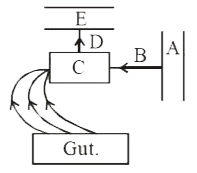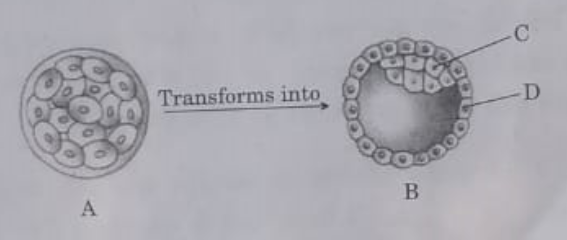The diagnostic test that confirms typhoid in humans in
A) ELISA
B) Widal
C) MRI
(D) Amniocentesis
To solve the question regarding the diagnostic test that confirms typhoid in humans, we will analyze each option provided:
1. Understanding Typhoid:
- Typhoid fever is caused by the bacterium *Salmonella typhi*. It is essential to identify the correct diagnostic test that can confirm the presence of this bacterium in humans.
2. Evaluating the Options:
- A) ELISA:
- ELISA stands for Enzyme-Linked Immunosorbent Assay. It is a general test used to detect antibodies or antigens in various diseases, but it is not specific for typhoid.
- B) Widal:
- The Widal test is specifically designed to detect the presence of antibodies against *Salmonella typhi* in the blood, making it a diagnostic test for typhoid fever.
- C) MRI:
- MRI (Magnetic Resonance Imaging) is an imaging technique used to visualize internal structures of the body. It is not used for diagnosing typhoid.
- D) Amniocentesis:
- Amniocentesis is a procedure used during pregnancy to collect amniotic fluid for testing genetic disorders. It is not related to diagnosing typhoid.
3. Conclusion:
- After evaluating all the options, the Widal test (Option B) is the correct diagnostic test that confirms typhoid in humans.
Final Answer: B) Widal
---
- Typhoid fever is caused by the bacterium *Salmonella typhi*. It is essential to identify the correct diagnostic test that can confirm the presence of this bacterium in humans.
- A) ELISA:
- ELISA stands for Enzyme-Linked Immunosorbent Assay. It is a general test used to detect antibodies or antigens in various diseases, but it is not specific for typhoid.
- B) Widal:
- The Widal test is specifically designed to detect the presence of antibodies against *Salmonella typhi* in the blood, making it a diagnostic test for typhoid fever.
- C) MRI:
- MRI (Magnetic Resonance Imaging) is an imaging technique used to visualize internal structures of the body. It is not used for diagnosing typhoid.
- D) Amniocentesis:
- Amniocentesis is a procedure used during pregnancy to collect amniotic fluid for testing genetic disorders. It is not related to diagnosing typhoid.
- After evaluating all the options, the Widal test (Option B) is the correct diagnostic test that confirms typhoid in humans.
Topper's Solved these Questions
Similar Questions
Knowledge Check
- Question 1 - Select One
Which of the following statements regarding the disease typhoid is/are correct ?
(i) Salmonella typhi are the pathogenic bacteria which enter human intestine through contaminated food and water migrate to other organs through blood.
(ii) Sustained high fever(39∘C to 40∘C), weakness, stomach pain, constipation, headache and loss of appetite are some common symptons of typhoid.
(iii) Widal test is used for diagnosis of typhoid fever.
(iv) The patient of this disease is not required to be treated with antibiotics.A(i) and (ii)B(iii) and (v)C(i), (ii) and (iv)D(i), (ii), (iii) and (iv)
(a) Name the causative agent of typhoid in humans. (b) Name the test administered to confirm the disease. (c) How does the pathogen gain entry into the human body ? Write the diagnostic symptoms and mention the body organ that gets affected in severe cases.
View SolutionElectromagnetic waves used as a diagnostic tool in medicine are (A) X-rays (B) ultraviolet rays (C) infrared radiation (D) ultrasonic waves
View SolutionGiven below are asserton and reason point out If both are true with reason being correct explanation (A) both are true but reason is not correct explation (B) assertion is true but reason is worng ( C) and both are wrong (D )
Assertion . Amniocentesis is banned
Reason : - AMniocentesis gives inforamtion about fortal abnormalitiesView SolutionWhich are cutting teeth in humans ?
(a) Canines
(b) Molars
(c) Premolars
(d) IncisorsView SolutionFollowing sketch represent circulation in human, Identify B, C and D.
 View Solution
View SolutionStudy the given diagram: A is an embryonic stage that gets transformed into B, which in turn gets implanted in the endometrium in human females.

(a) Identify A, B and its parts C and D.
(b) Stage the fate of C and D in the course of embryonic development in humans.View SolutionMatch the disease in Column I with the appropriate items
(vector/ pathogen/ diagnostic test/ treatment) in Column II
Column - IColumn - IIa.Ringwormi.Aedesb.Ascariasisii.Widal test c.Dengueiii.Blockage of the intestinal passaged.Typhoidiv.Trichophyton
(1) a-(iv) ,b-(iii), c-(i), d- (ii)
(2) a-(ii) ,b-(iii), c-(i), d- (iv)
(3) a-(iv) ,b-(i), c-(ii), d- (iii)
(4) a-(i) ,b-(ii), c-(iii), d- (iv)View Solution

